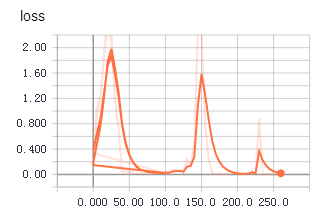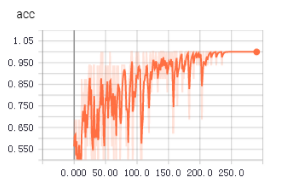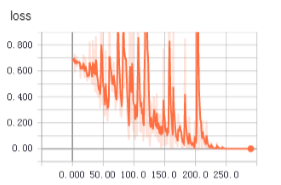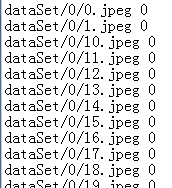tensorflowxun训练自己的数据集之从tfrecords读取数据
当训练数据量较小时,采用直接读取文件的方式,当训练数据量非常大时,直接读取文件的方式太耗内存,这时应采用高效的读取方法,读取tfrecords文件,这其实是一种二进制文件。tensorflow为其内置了各种存储和读取的函数,方便调用。
不知道为啥,从tfrecords中读取数据用于训练时,收敛得更快,更平稳。上面两个图是使用tfrecords的准确率和loss值变化,下面是直接读取文件的准确率和loss值变化。




1 生成记录样本的记录文件
root_dir = os.getcwd() def getTrianList():
with open("train.txt","w") as f:
for file in os.listdir(root_dir+'\\dataSet'):
for picFile in os.listdir(root_dir+"\\dataSet\\"+file):
f.write("dataSet/"+file+"/"+picFile+" "+file+"\n")
print(picFile)
if __name__=="__main__":
getTrianList()
将样本文件路径和标签统一记录到一个txt中,后面生成tfrecords文件就是通过读取这些信息。

注意文件路径和标签之间采用空格,不要使用制表符。
2 读取txt存于数组中
def load_file(example_list_file):
lines = np.genfromtxt(example_list_file,delimiter=" ",dtype=[('col1', 'S120'), ('col2', 'i8')])
examples = []
labels = []
for example,label in lines:
examples.append(example)
labels.append(label)
#convert to numpy array
return np.asarray(examples),np.asarray(labels),len(lines)
这段代码主要用来读取第1步生成的txt,将文件路径和标签存于数组中
3 读取图片
def extract_image(filename,height,width):
print(filename)
image = cv2.imread(filename)
image = cv2.resize(image,(height,width))
b,g,r = cv2.split(image)
rgb_image = cv2.merge([r,g,b])
return rgb_image
使用cv2读取图片文件
4 转化为tfrecords文件
def trans2tfRecord(trainFile,name,output_dir,height,width):
if not os.path.exists(output_dir) or os.path.isfile(output_dir):
os.makedirs(output_dir)
_examples,_labels,examples_num = load_file(train_file)
filename = name + '.tfrecords'
writer = tf.python_io.TFRecordWriter(filename)
for i,[example,label] in enumerate(zip(_examples,_labels)):
print("NO{}".format(i))
#need to convert the example(bytes) to utf-8
example = example.decode("UTF-8")
image = extract_image(example,height,width)
image_raw = image.tostring()
example = tf.train.Example(features=tf.train.Features(feature={
'image_raw':_bytes_feature(image_raw),
'height':_int64_feature(image.shape[0]),
'width': _int64_feature(32),
'depth': _int64_feature(32),
'label': _int64_feature(label)
}))
writer.write(example.SerializeToString())
writer.close()
def _int64_feature(value):
return tf.train.Feature(int64_list=tf.train.Int64List(value=[value])) def _bytes_feature(value):
return tf.train.Feature(bytes_list=tf.train.BytesList(value=[value]))
5 从tfrecords中读取训练数据
def read_tfRecord(file_tfRecord):
queue = tf.train.string_input_producer([file_tfRecord])
reader = tf.TFRecordReader()
_,serialized_example = reader.read(queue)
features = tf.parse_single_example(
serialized_example,
features={
'image_raw': tf.FixedLenFeature([], tf.string),
'height': tf.FixedLenFeature([], tf.int64),
'width':tf.FixedLenFeature([], tf.int64),
'depth': tf.FixedLenFeature([], tf.int64),
'label': tf.FixedLenFeature([], tf.int64)
}
)
image = tf.decode_raw(features['image_raw'],tf.uint8)
#height = tf.cast(features['height'], tf.int64)
#width = tf.cast(features['width'], tf.int64)
image = tf.reshape(image,[32,32,3])
image = tf.cast(image, tf.float32)
image = tf.image.per_image_standardization(image)
label = tf.cast(features['label'], tf.int64)
print(image,label)
return image,label
从tfrecords文件中读取image和label,训练的时候,直接使用tf.train.batch函数生成用于训练的batch即可。
image_batches,label_batches = tf.train.batch([image, label], batch_size=16, capacity=20)
其余的部分跟之前的训练步骤一样。
tensorflowxun训练自己的数据集之从tfrecords读取数据的更多相关文章
- TensorFlow学习笔记——LeNet-5(训练自己的数据集)
在之前的TensorFlow学习笔记——图像识别与卷积神经网络(链接:请点击我)中了解了一下经典的卷积神经网络模型LeNet模型.那其实之前学习了别人的代码实现了LeNet网络对MNIST数据集的训练 ...
- Fast RCNN 训练自己的数据集(3训练和检测)
转载请注明出处,楼燚(yì)航的blog,http://www.cnblogs.com/louyihang-loves-baiyan/ https://github.com/YihangLou/fas ...
- 【faster-rcnn】训练自己的数据集时的坑
既然faster-rcnn原版发表时候是matlab版代码,那就用matlab版代码吧!不过遇到的坑挺多的,不知道python版会不会好一点. ======= update ========= 总体上 ...
- 【Tensorflow系列】使用Inception_resnet_v2训练自己的数据集并用Tensorboard监控
[写在前面] 用Tensorflow(TF)已实现好的卷积神经网络(CNN)模型来训练自己的数据集,验证目前较成熟模型在不同数据集上的准确度,如Inception_V3, VGG16,Inceptio ...
- 目标检测算法SSD之训练自己的数据集
目标检测算法SSD之训练自己的数据集 prerequesties 预备知识/前提条件 下载和配置了最新SSD代码 git clone https://github.com/weiliu89/caffe ...
- 可变卷积Deforable ConvNet 迁移训练自己的数据集 MXNet框架 GPU版
[引言] 最近在用可变卷积的rfcn 模型迁移训练自己的数据集, MSRA官方使用的MXNet框架 环境搭建及配置:http://www.cnblogs.com/andre-ma/p/8867031. ...
- caffe训练自己的数据集
默认caffe已经编译好了,并且编译好了pycaffe 1 数据准备 首先准备训练和测试数据集,这里准备两类数据,分别放在文件夹0和文件夹1中(之所以使用0和1命名数据类别,是因为方便标注数据类别,直 ...
- 使用yolo3模型训练自己的数据集
使用yolo3模型训练自己的数据集 本项目地址:https://github.com/Cw-zero/Retrain-yolo3 一.运行环境 1. Ubuntu16.04. 2. TensorFlo ...
- 【tf.keras】在 cifar 上训练 AlexNet,数据集过大导致 OOM
cifar-10 每张图片的大小为 32×32,而 AlexNet 要求图片的输入是 224×224(也有说 227×227 的,这是 224×224 的图片进行大小为 2 的 zero paddin ...
随机推荐
- 编程之美 set 4 找到符合条件的数
题目 任意给定一个正整数 N, 求一个最小的正整数 M (M > 1), 使得 N*M 的十进制表达式中只有 0 和 1. 解法 1. 枚举0,1能够组成的数字, 可以组成一颗二叉树 然后由 B ...
- linux命令之rpm
1.查询一个包是否被安装的命令rpm -q < rpm package name> 2.列出所有被安装的rpm package 命令rpm -qa
- STM32 PWM的输出与Keil软件仿真
导读:PWM(Pulse Width Modulation)控制——脉冲宽度调制技术,通过对一系列脉冲的宽度进行调制,来等效地获得所需要波形(含形状和幅值). PWM控制技术在逆变电路中应用最广,应用 ...
- Java之自动拆装箱
顾名思义,自动拆装箱就是将基本类型和包装类进行自动的互相转换. JDK5.0后,将自动装箱/拆箱引Java中. 自动装箱的过程:每当需要一种类型的对象时,这种基本类型就自动地封装到与它相同类型的包装中 ...
- 一、Android Studio入门——Eclipse快捷键配置
[Studio总体介绍] 第一个是运行. 第二个是Debug. 是Studio的设置界面. 工程的配置. Sync,更改配置.导入JAR包,都会去Sync一次. SDK Manager. ...
- 使用async/await——Nodejs+ExpressJs+Babel
在使用诸如restify/expressjs等Nodejs Web Framework时,我们最头疼的问题就是回调黑洞. 虽然后又Koa/Koa2号称“The Next Framework”使用co解 ...
- js数组和字符串去重复几种方法
js数组去重复几种方法 第一种:也是最笨的吧. Array.prototype.unique1 = function () { var r = new Array(); label:for(var i ...
- 初级Java面试题 - JavaSE篇
p{font-size:18px;} li{font-size:18px;} 加入我的QQ群(701974765) 获取更多好用又好玩的软件,还有不定期发放的福利呦(- ̄▽ ̄)- Java基本数据类型 ...
- 用于把List<Object>转换成Map<String,Object>形式
/** * 用于把List<Object>转换成Map<String,Object>形式,便于存入缓存 * @author zhang_bo * @param keyName ...
- smp,numa,mpp,umam,olap,dss,oltp,greenplum,presto
SMP.NUMA.MPP体系结构介绍 从系统架构来看,目前的商用服务器大体可以分为三类,即对称多处理器结构 (SMP : Symmetric Multi-Processor) ,非一致存储访问结构 ( ...
